


Art Chester's Goon, Star of the Movies and the 1939 National Air Races
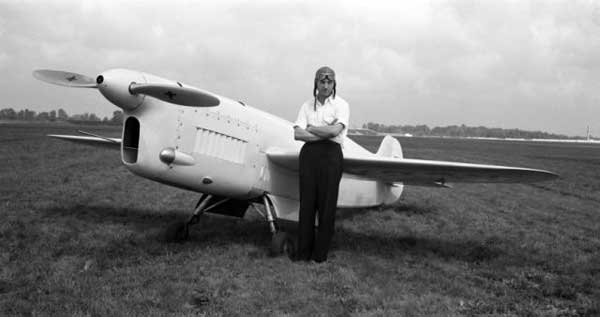
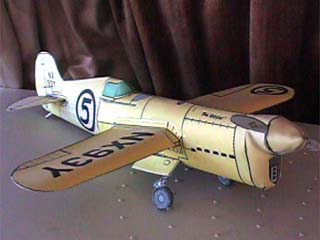 Introduced at the 1939 National Air Races by Art Chester, the GOON won 2nd place in the Greve Trophy race at 250.42 mph. In the 1938 Thompson, Chester was forced out with propeller problems. In 1939, Chester won the Grieve race at 263. 39 mph but again had to withdraw from the Thompson with engine troubles.
Introduced at the 1939 National Air Races by Art Chester, the GOON won 2nd place in the Greve Trophy race at 250.42 mph. In the 1938 Thompson, Chester was forced out with propeller problems. In 1939, Chester won the Grieve race at 263. 39 mph but again had to withdraw from the Thompson with engine troubles.
The Goon is much like the Crosby CR-3 and the Rider racers. One unique feature is the retractable landing gear and the recessed louvers in the nose.
The tiny wheels and landing gear (evidently, just large enough!), make this plane look a little like a goon. The circle around the number '5' was added for the movie ,Tail Spin, which featured the Chester Goon.
What People Say...
I built this as a result of finding a step-by-step review article that Scott had posted under the FG imprimatur online. In the article, an "expert" builder (unknown to me) said he had built several Halinski and GPM models and wanted to see if his vast experience enabled him easily and quickly to build "simple" models like the FG ones. Then he built the Goon and literally made a hash out of it. Scott posted an addendum to the model review asking if a designer would come forward to fix the badly fitting nose that this builder photographed and displayed and correct other deficiencies.
In fact, this turned out for me (not at all an expert builder) quite wonderfully. It is a very fine representation of the original race plane when compared to 3-view drawings in books that I have. The nose fit perfectly (I can't conceive of what kind of problems the other modeler felt he had with this). I don't care for petal spinners, but this one worked. The only change I made was in the louvers on the side of the cowl. Chip had a neat idea in theory for these louvers, but these are better left uncut, and look fine that way. The "expert" modeler's photos showed that he also messed these louvers up, and pasted a patch from another print over his screw-up. Scott needs to take down the article if he can find it, and promote this model as well-done. Not a good first model, though (something that is true of all of the FG raceplane series). It must feel good to consider yourself an expert when it comes to paper models. In my case, I regularly get humbled by this hobby craft.
I am a fan of racing planes and live in the neighborhood here in Virginia where Cook Cleland lived (about a block away) when he was racing (and won with) that clipped-wing Corsair in the National Air Races after WWII. As a kid, I lived near Cleveland, and followed the races (My brother and my Dad attended, but I was too little to go ...and probably too much trouble to take along). - Alan Wheeler
![]()
WITH THE COMPETITION getting tougher, Art Chester sold the "Jeep" and arrived at the 1938 National Air Races with a new mid-wing speedster. The ship was named the "Goon" (Chester named his ships from characters in the "Popeye" comic strip) and it packed a six cylinder Menasco Buccaneer engine as the powerplant. The lines were sleek and every portion of the plane was completely streamlined. It was equipped with a two position French Ratier controllable pitch propeller of the same type used by Michel Detroyat on his French Caudron in 1936. Prior to receiving the prop, Chester had mounted the engine so that it would turn clockwise. Upon delivery of the prop, he found that the French had changed the twist to conform with our engines, so the necessary changes had to be made.
The wing was cantilever in design, constructed of spruce, covered with plywood and then in turn covered with fabric. This was also true of the tail surfaces. The landing gear was fully retractable and operated manually. The wheels retracted into the fuselage, actuating the doors which enclosed the gear, thus leaving a smooth surface on the underside of the fuselage. The wing span was 18 ft. 6 in. and the length 20 ft. 6 in. The same familiar cream color as was used on the "Jeep" was used on the "Goon" and the race number 5 was added for the Nationals.
The little ship proved to be a worthy successor of the "Jeep". It placed second in the Greve Trophy Race with a speed of 250.42 mph finishing behind Tony LeVier in his Keith-Rider with less than one mile per hour difference in the speeds. During the early laps Tony and Art fought it out, changing spots at every lap. Chester developed an oil leak which smeared his windshield, causing him to cut No. 2 pylon. As he re circled it, he ended up a half lap behind. At this point LeVier, thinking he had a safe lead, throttled back to save his engine for the Thompson. He was not aware of the little cream job closing in on him until it was almost too late to pour on the coal. He did spot Chester in time and went on to win the race, but by a very narrow margin.
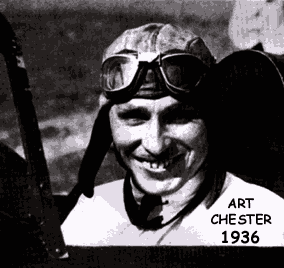 In the Thompson Trophy Race Chester didn't fare so well. He
was in faster company, of course- Earl Ortman in his Marcoux-Bomberg,
Roscoe Turner in his Turner-Laird, and Steve Wittman in his "Bonzo".
For 20 laps Chester managed to hold fifth place, right behind
Leigh Wade in the Military Pursuit, a development of Frank Hawks'
racer. Then the Ratier propeller again started to throw oil and
Chester had to drop out.
In the Thompson Trophy Race Chester didn't fare so well. He
was in faster company, of course- Earl Ortman in his Marcoux-Bomberg,
Roscoe Turner in his Turner-Laird, and Steve Wittman in his "Bonzo".
For 20 laps Chester managed to hold fifth place, right behind
Leigh Wade in the Military Pursuit, a development of Frank Hawks'
racer. Then the Ratier propeller again started to throw oil and
Chester had to drop out.
Pleased with the performance of the "Goon", Chester brought it again to the Nationals in 1939. The little ship looked the same but some effort must have been put forth, for the speed had been increased to 264 mph. As the flag dropped for the Greve Race, again it was LeVier and Chester as chief contenders. This time it was LeVier who had hard luck. On the 11th lap he developed mag trouble and had to drop out after being in the lead that distance. Chester roared on to the finish, setting a speed of 263.39 mph for the race. This was a new speed record for a while and certainly reduced his stability. You've got to be a good pilot to handle a job like that. But I wouldn't worry about Steve; he is tops in his line when it comes to flying the jitterbugs.
After a few years of this sort of trimming down, he found, though, that he'd cut off more than he could chew. He brought the ship to a lowered efficiency, dropping off speed instead of increasing it, and making it mush rather than zip. Lately he has been working towards increased reliability, although I have had no report on his progress.
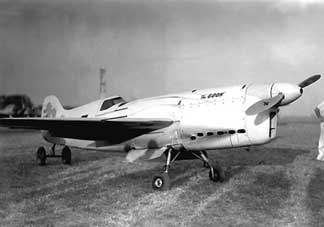 We can definitely trace to the little racing craft the important
item of increased take-off horsepower ratings for commercial transports.
Usages in closed course racing proved excessive manifold pressures
could be feasible. Pratt & Whitney profited by my use of one
of their engines for a few years of intense racing. They worked
it over and then released it, in modification, for commercial
use, utilizing the knowledge gained on the proving ground of the
closed course. This is practically the same engine used by Jackie
Cochran in her green Beechcraft which showed to such good advantage
in the 1937 Bendix. The Wasp Senior, a 550 hp take-off engine,
was used by me for three years with power up to 830 hp without
damage to the engine. After this test the modification was released
with a 600 hp rating.
We can definitely trace to the little racing craft the important
item of increased take-off horsepower ratings for commercial transports.
Usages in closed course racing proved excessive manifold pressures
could be feasible. Pratt & Whitney profited by my use of one
of their engines for a few years of intense racing. They worked
it over and then released it, in modification, for commercial
use, utilizing the knowledge gained on the proving ground of the
closed course. This is practically the same engine used by Jackie
Cochran in her green Beechcraft which showed to such good advantage
in the 1937 Bendix. The Wasp Senior, a 550 hp take-off engine,
was used by me for three years with power up to 830 hp without
damage to the engine. After this test the modification was released
with a 600 hp rating.
Let's take the need for a higher quality gas; gas which would not detonate under extreme supercharging. We worked with that with many brands, and finally got it in a 100 octane gas of a standard make. This is now used largely by transport lines.
Spark plugs showed deficiency under high pressure. We discovered this need several years before the Army or airlines went into experimentation. We used our ships as a testing laboratory, using every spark plug we could get hold of. Some of these custom-built little gadgets cost the companies as much as $50 each to prepare in sets of 28, but they cooperated beautifully.
We finally licked the spark plug situation when two companies, Bendix and B-G, combined to make a spark plug that stood the gaff and actually delivered for us. These are the plugs currently used not only by closed course and cross-country racers, but by the airlines and military forces. Which is certainly a good mark on the closed-course side of the ledger.
Increased speeds called for a modification of propeller design which we arrived at by the "cut and tried" method. Then came the demand for cowlings of greater strength. As greater speeds developed steps had to be taken to keep the natural tendency of the cowling from being pulled into the propeller. This happened to me on several occasions and isn't a bit funny.
This, naturally, demanded new structural designs and streamlining, which, incidentally, are not yet perfect by a long shot. The streamlined cowlings and their cooling devices are directly traceable to the racing craft. Your modern airliner owes much of its bullet shaped figure to the little "jeep" that careened around the pylons.
Efforts towards greater speeds required a retractable landing gear which would reduce resistance. Our racing ships were the first to experiment with this type of gear. An early instance was the Army's Verville racer of 1925 or 1926. This was the first practical installation, to my memory, although it was tried out about the same time in England. Little came of the British experiment. Earlier installations were heavy, complicated and unreliable. The landing gear now used by racing planes is of minimum weight and never causes the pilot a bit of worry.
Now . . . to get back to the original idea of this yarn: Why did I quit this tremendously fascinating and allegedly profitable business of closed-course racing for the salary and uniform of a first officer for Canadian Colonial Airways? (I heard that remark! It is not the stewardesses!)
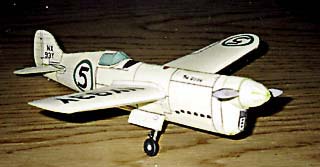 |
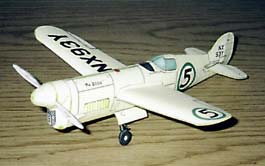 |
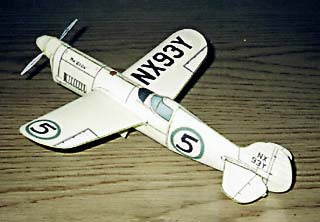 |
Art Chester would be right proud over Wayne White's Goon models. High FIVE for Wayne! |
Comes a time, as the story books say, in every young man's life, when security looks attractive. I have made a lot of money; I've spent more. Prize money at air races looks big when it is in the catalog and probably you have often envied the winner of the Bendix or Thompson for the big purse he took home. But listen to one who knows.
The biggest purse I ever won in one day's racing was $14,000. Quite a sizable sum for a few minutes' work, you say? Well, yes, but consider the pintail cost of the ship I flew - a mere matter of $50,000. To this, for this particular race, I added $7,500 in cash for preparation. Now, how much did I get out of that $14,000?
Colonel Turner won approximately $24,000 last year at Cleveland when he copped the Thompson. I'll wager mighty little of that was profit.
Racing pilots may fly fast, but they are not flighty. As a first officer for Canadian Colonial Airways I can see a definite future for myself in the industry I love. My experience as a racing pilot has made me, if anything, more conservative and less inclined to gamble and take unnecessary chances. When I flew my own ship I went over it carefully for flaws in the works; as a pilot for a great airline this is done for me. I'm satisfied to take the word of the competent mechanics of the line. I never took anybody's word but my own before.
I'm not alone in deciding to become an airline pilot. Harold
Neumann, one-time Thompson Trophy winner, plane designer and partner
of Benny Howard, beat me to it by several years when he joined
TWA. Shortly after that Roger Don Rae, one of the nation's greatest
speed pilots, joined the same outfit and young Bob Buck who, although
he wasn't a racing pilot was a nationally-known record flyer,
decided he too would sit in the right-hand seat of a transport
cockpit.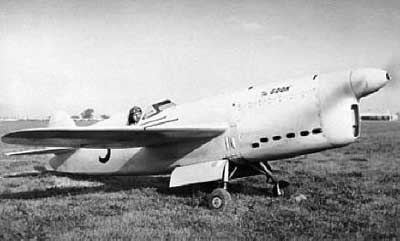
Even the resplendent Roscoe has become a business man-a vice-president in charge of something or other for Porterfield-Turner planes. He's going to race again of course, but he's building up to a future.
My interests in experimentation will never cease. I'll always be interested in new aviation developments. My engineering training and an inquisitive mind make that imperative, But my guinea pig days are over. My old Maroux-Bromberg racer, bless it, will be on the starting line at the 1939 Nationals in Cleveland and I honestly think it will win the Thompson this year. But my interests will be purely platonic. I'll be in the cockpit in spirit, helping whoever flies it with my subconscious support.
But me . . . if I'm not in the grandstand. I'll be somewhere between Newark and Montreal in the right hand seat of a Canadian Colonial Airways DC-3.
In spite of Earl Ortman's statements about retiring from air racing, the lure of competition apparently got the better of him. He did not view the 1939 races as a spectator, but piloted the familiar MarcouxBromberg to third place in the Thompson with a speed of 254.435 mph. Ortman also appeared in postwar Thompson competition winning third place in 1946 in a P-51. He also flew midgets in the Goodyear class at Miami in 1948.
Chester fared no better in the 1939 Thompson Race than he had the year before. He held third place for 17 laps, averaging 264 mph, and then engine trouble caused him to withdraw. Due to the international situation this was the last air race held for the next eight years, so the "Goon" and many others were placed in storage to gather dust.

Chester returned to the race game in 1947 and was elected president of the Professional Race Pilots Association. This time he built two midget racers for the 190 cu. in. class for the Goodyear Races. The two ships were almost identical, named "Sweet' Pea" and "Sky Baby". They were race equipped with V-type butterfly tails, but were first tested with normal tail surfaces. The streamlining on these ships had been carried out to every portion of the racers and their performance reflected many years of experience. The engine was completely enclosed, the cooling air being drawn through a spinner opening by a blower fan placed in back of the propeller.
It was rumored that these ships did not handle so well in the turns. This may have been true, as Chester met his death while rounding a pylon at the San Diego Races in 1949. Thus aviation lost another great man, but not before he had made his mark in the sky- one which he and all of us in aviation can be proud of.
Specifications
Span 18 ft. 6 in. Length 20 ft. 6 in. Engine Menasco C6S4 290 hp |
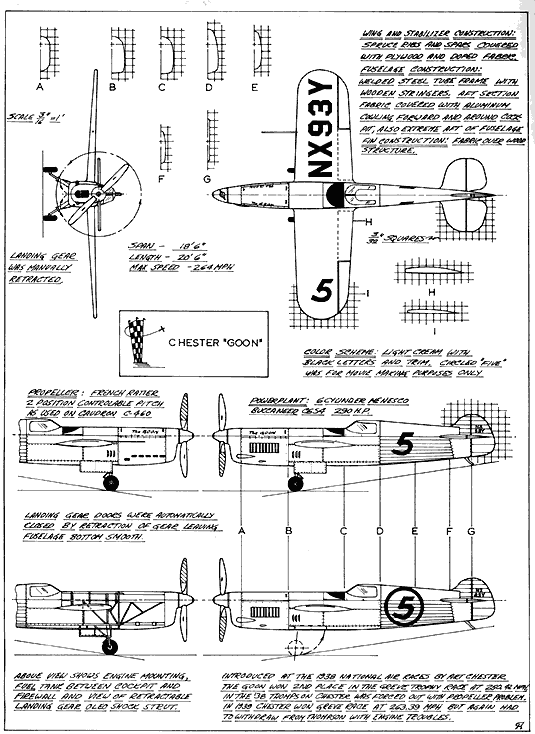
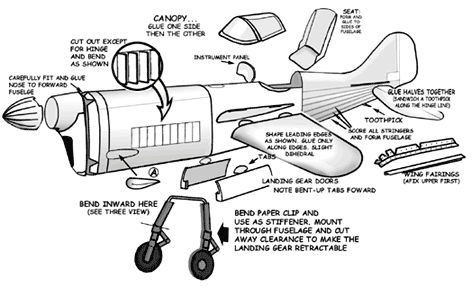
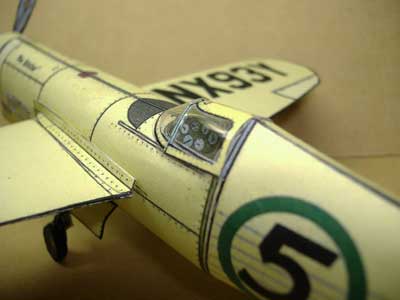 |
Clear Cabin Chester Goon Racer submitted by Bob Martin. Thanks Bob! |



